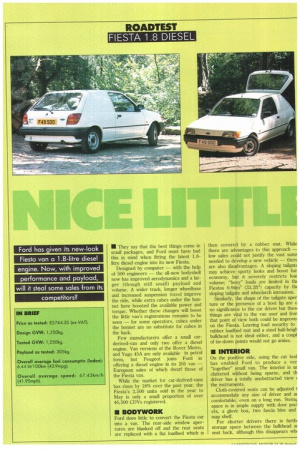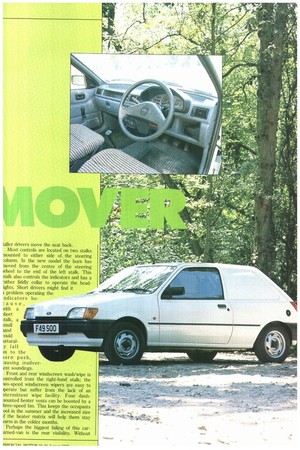• They say that the best things come in small
Page 52

Page 53

Page 54

Page 55

Page 56

If you've noticed an error in this article please click here to report it so we can fix it.
packages, and Ford must have had this in mind when fitting the latest 1.8litre diesel engine into its new Fiesta.
Designed by computer — with the help of 500 engineers — the all-new bodysheli now has improved aerodynamics and a larger (though still small) payload and volume. A wider track, longer wheelbase and increased suspension travel improve the ride, while extra cubes under the bonnet have boosted the available power and torque. Whether these changes will boost the little van's registrations remains to be seen — for some operators, cubes under the bonnet are no substitute for cubes in the back.
Few manufacturers offer a small carderived-van and only two offer a diesel engine. Van versions of the Rover Metro, and Yugo 45A are only available in petrol form, but Peugeot joins Ford in offering a diesel engine in its 205 van — European sales of which dwarf those of the Fiesta van.
While the market for car-derived-vans has risen by 18% over the past year, the Fiesta's 2,500 units sold in the year to May is only a small proportion of over 46,500 CDVs registered.
Ford does little to convert the Fiesta car into a van. The rear-side window apertures are blanked off and the rear seats are replaced with a flat loadbed which is then covered by a rubber mat. While there are advantages to this approach — low sales could not justify the vast sumt needed to develop a new vehicle — then are also disadvantages. A sloping tailgatf may achieve sporty looks and boost fue economy, but it severely restricts lox volume; "boxy" loads are limited in tlu Fiestas 0.94m3 (33.2ft3) capacity by flu sloping tailgate and wheelarch intrusions.
Similarly, the shape of the tailgate aper tare or the presence of a boot lip are a no significance to the car driver but these things are vital to the van user and fron that point of view both could be improve' on the Fiesta. Leaving load security to rubber loadbed mat and a steel half-heigh bulkhead is not ideal either, and a coupl of tie-down points would not go amiss.
On the positive side, using the car bod has enabled Ford to produce a ver "together" small van. The interior is ur cluttered without being sparse, and th driver has a totally unobstructed view the instruments.
Cloth-covered seats can be adjusted I accommodate any size of driver and az comfortable, even on a long run. Stora space is in ample supply with door pod ets, a glove box, two fascia bins and map shelf.
For shorter drivers there is furthe storage space between the bulkhead at seat back, although this disappears Mil Most controls are located on two stalks mounted to either side of.. the steering 2olumn. In the new model the horn has moved from the centre of the steering wheel to the end of the left stalk. This 5talk also controls the indicators and has a rather fiddly collar to operate the headights. Short drivers might find it problem operating the ndicators be with a ;hort ;talk, a ;mall )and :ould laturaly fall )n to the torn push, ;ausing inadverent soundings.
Front and rear windscreen wash/wipe is ;ontrolled from the right-hand stalk; the wo-speed windscreen wipers are easy to perate but suffer from the lack of an ntermittent wipe facility. Four dashnounted heater vents can be boosted by a hree-speed fan. This keeps the occupants ool in the summer and the increased size the heater matrix will help them stay farm in the colder months.
Perhaps the biggest failing of this carurned-van is the rear visibility. Without rear-side windows the standard car mirrors leave a blind spot on the nearside big enough to lose a Transit in. The offside does not fare much better but the driver can look back around the B-post for any "lost" vehicles — which has its own dangers. Inadequate mirrors make driving in heavy traffic very stressful, a failing for which there is no excuse.
When driving the Fiesta, the fact that it has a diesel engine can virtually be forgotten until fuel is needed. New glow plugs do their work in about four seconds and a noise insulation package removes most of the taxi-like noises to keep the neighbours happy. By taking further steps, like replacing the injection pump's primary gears with a belt and re-working the combustion chambers, internal noise at tickover is kept down to 58.2dB(A). However, on tickover the engine rocks in its mountings making the whole van jump around in an unpleasant manner. Once off tickover the engine becomes quiet, smooth and responsive with a noise level of 77.1dB(A) • at the maximum legal speed.
The re-worked indirect-injection engine is a high-revving unit which lacks bottomend pulling power. There is plenty of power available but this is further up the rev range leading one to drive it like a petrol engine, thereby losing some of the diesel's economy.
With a higher swept volume, by virtue of increased bore and stroke, increased power and torque, the van is very quick — even when laden — provided that good use is made of the gears to keep the engine revs up.
From a standing start, 80Icm/h (50mph) is reached in just over 14 seconds and the motorway limit can be broken in third gear.
Engine and gearbox are well matched with the lower ratios giving rapid acceleration while a long fifth gear makes for restful driving on motorways. Keeping up with city traffic around one-way systems and the like requires the use of third gear, while dropping into second will leave a lot of drivers admiring the Fiesta's stylish rear lights.
A fiddly collar operates the side/headlights and it is all too easy to sound the horn when trying to use the indicators. This latest generation Fiesta has a larger "footprint" achieved by pushing the wheels further out towards the corners. The wheelbase has been extended by 154nun (6.1in) while the front and rear track has been widened by 31.5mm (1.2in) and 65.3mm (2.6in), respectively.
Re-designed rear suspension has the wheels carried on trailing arms which are connected by a torsion beam axle. This gives an extra 25mm (lin) of suspension travel over the old model and allows the spring rate to be softened. MacPherson strut front suspension is retained, although wheel location struts have been modified and the spring rate stiffened to reduce roll.
In practice, the result of these changes is that the laden van's handling would put many saloon cars to shame. While the loaded van sits down a long way on the rear suspension there is still enough travel to absorb all but the worst bumps. Unladen, the ride is equally good, the rear end does not jump around causing the familiar jarring often found with empty vans and pickups. In general, the handling is excellent. If pushed hard into a corner there is a small amount of understeer accompanied by some body roll and, apart from some tyre squeal, the whole process is entirely without drama.
Despite a longer wheelbase the Fiesta still has a tight turning circle, needing only 10.5m (34.5ft) between walls to perform a U-turn. This manoeuvrability would make the van an ideal city vehicle if the driver was able to exploit it. However, the poor mirrors do not inspire the confidence necessary to do this, so the Fiesta must wait its turn in a slow-moving queue.
Braking is provided by hydraulicallyoperated servo-assisted front discs and rear drums. Under emergency conditions the front wheels lock but the vehicle remains in a straight line. In normal use, the brakes are progressive with a good feel and they instill confidence.
The 1.8-litre indirect-injection engine is not the most economical we have tested. Once on the move the engine sounds like a petrol, responds like a petrol and demands to be driven like a petrol. Maximum power is reached at 4,800rpm while maximum torque is delivered at 2,500rpm. These figures are just 400 and 200rpin below their respective speeds on the 1.1litre petrol engine.
Having increased the swept volume of the diesel, fuel economy has suffered slightly with both the Fiesta and Escort returning 2-3% worse figures than their 1.6-litre predecessor. Considering all these facts, the Fiesta returned a creditable 6.441it/100km (43.9mpg) fully laden round our test route.
However, this figure does not compare favourably with the record-breaking Peugeot 205 which returned 5.291it1100km over the same route and which also has a superior payload but costs £600 more than the basic Fiesta.
With only one direct competitor, comparisons with the Fiesta are difficult to draw. Fiat produces the estate-car-derived Citivan but, when looking for a small commercial vehicle, the superior payload and volume offered by purpose-built vans such as the Renault Express, Citroen C15 or Fiat Florin() cannot be ignored some cost less than the Fiesta. For this reason we use these purpose-built vans, along with the Peugeot 205, in our comparison charts.
Renault's Extra is the biggest selling commercial vehicle in Europe, and clocked up 11 units for each Fiesta sold in 1988. Ford takes this very seriously and it is possible that we will see a high-cube version of the Fiesta in the future (CM 3-9 August).
Those who only need the very modest carrying capacity offered by the Fiesta will be rewarded by a better ride than any purpose-built van can give. Drivers used to petrol-engined vans will be pleasantly surprised by the performance of Ford's new 1,800cc diesel engine and may even save some money on fuel into the bargain.
Despite the few reservations mentioned, the Fiesta is a delightful van to drive but its load restriction keeps reg istration numbers low. A high-cube version could change this situation dramatical ly in Ford's favour and give other manufacturers more than just carrying capacity to think about.
E by Colin Sowman




































































































